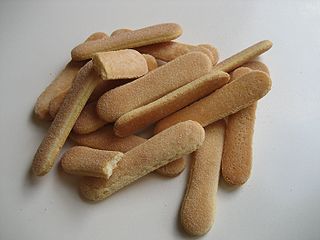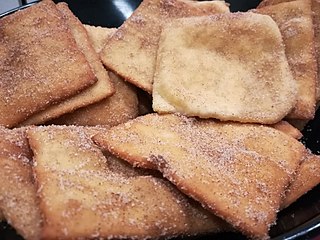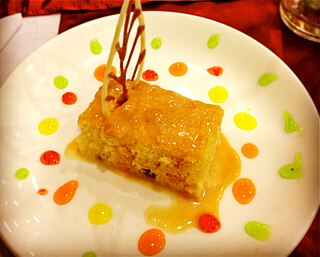
Cake is a flour confection made from flour, sugar, and other ingredients and is usually baked. In their oldest forms, cakes were modifications of bread, but cakes now cover a wide range of preparations that can be simple or elaborate and which share features with desserts such as pastries, meringues, custards, and pies.

Trifle is a layered dessert of English origin. The usual ingredients are a thin layer of sponge fingers or sponge cake soaked in sherry or another fortified wine, a fruit element, custard and whipped cream layered in that ascending order in a glass dish. The contents of a trifle are highly variable and many varieties exist, some forgoing fruit entirely and instead using other ingredients, such as chocolate, coffee or vanilla. The fruit and sponge layers may be suspended in fruit-flavoured jelly, and these ingredients are usually arranged to produce three or four layers. The assembled dessert can be topped with whipped cream or, more traditionally, syllabub.

Hungarian or Magyar cuisine is the cuisine characteristic of the nation of Hungary, and its primary ethnic group, the Magyars. Hungarian cuisine has been described as being the spiciest cuisine in Europe. This can largely be attributed to the use of their piquant native spice, Hungarian paprika, in many of their dishes. A mild version of the spice, Hungarian sweet paprika, is commonly used as an alternative. Traditional Hungarian dishes are primarily based on meats, seasonal vegetables, fruits, bread, and dairy products.

A wedding cake is the traditional cake served at wedding receptions following dinner. In some parts of England, the wedding cake is served at a wedding breakfast; the 'wedding breakfast' does not mean the meal will be held in the morning, but at a time following the ceremony on the same day. In modern Western culture, the cake is usually on display and served to guests at the reception. Traditionally, wedding cakes were made to bring good luck to all guests and the couple. Nowadays, however, they are more of a centerpiece to the wedding and are not always even served to the guests. Some cakes are built with only a single edible tier for the bride and groom to share, but this is rare since the cost difference between fake and real tiers is minimal.

Cheesecake is a dessert made with a soft fresh cheese, eggs, and sugar. It may have a crust or base made from crushed cookies, graham crackers, pastry, or sometimes sponge cake. Cheesecake may be baked or unbaked, and is usually refrigerated.

Ladyfingers, or in British English sponge fingers, are low-density, dry, egg-based, sweet sponge cake biscuits roughly shaped like large fingers. They are a principal ingredient in many dessert recipes, such as trifles and charlottes, and are also used as fruit or chocolate gateau linings, and for the sponge element of tiramisu. They are typically soaked in a sugar syrup or liqueur, or in coffee or espresso for tiramisu. Plain ladyfingers are commonly given to infants, being soft enough for teething mouths, but easy to grasp and firm enough not to fall apart.

A mille-feuille, also known by the names Napoleon in North America, vanilla slice in the United Kingdom, and custard slice, is a French dessert made of puff pastry layered with pastry cream. Its modern form was influenced by improvements made by Marie-Antoine Carême.

A sopaipilla, sopapilla, sopaipa, or cachanga is a kind of fried pastry and a type of quick bread served in several regions with Spanish heritage in the Americas. The word sopaipilla is the diminutive of sopaipa, a word that entered Spanish from the Mozarabic language of Al-Andalus. The original Mozarabic word Xopaipa was used to mean bread soaked in oil. The word is derived in turn from the Germanic word suppa, which meant bread soaked in liquid.

A tres leches cake, dulce de tres leches, also known as pan tres leches or simply tres leches, is a sponge cake soaked in three kinds of milk: evaporated milk, condensed milk, and whole milk. The cake is popular throughout Latin America.

Torta caprese is a flourless Italian cake made with chocolate and either almonds or hazelnuts. Named for the island of Capri from which it originates, the cake is widely known and especially popular in nearby Naples, Italy.

A Swiss roll, jelly roll, roll cake, cream roll, roulade or Swiss log is a type of rolled sponge cake filled with whipped cream, jam, icing, or any type of filling. The origins of the term are unclear; in spite of the name "Swiss roll", the cake is believed to have originated elsewhere in Central Europe, possibly Austria or Slovenia. It appears to have been invented in the nineteenth century, along with Battenberg cake, doughnuts, and Victoria sponge. In the U.S., commercial snack-sized versions of the cake are sold with the brand names Ho Hos, Yodels, Swiss Cake Rolls, and others. A type of roll cake called Yule log is traditionally served at Christmas.

Torta is a culinary term that can, depending on the cuisine, refer to cakes, pies, flatbreads, sandwiches, or omelettes.

Molten chocolate cake is a French dessert that consists of a chocolate cake with a liquid chocolate core. It is named for that molten center, and it is also known as mi-cuit au chocolat, chocolat coulant ("flowing"), chocolate lava cake, or simply lava cake. It should not be confused with fondant au chocolat, a recipe that contains little flour, but much chocolate and butter, hence melting on the palate.

Dobos torte, also known as Dobosh, is a Hungarian sponge cake layered with chocolate buttercream and topped with caramel. The layered pastry is named after its inventor, Hungarian chef József C. Dobos, a delicatessen owner in Budapest. In the late 1800s, he decided to create a cake that would last longer than other pastries in an age when cooling techniques were limited. The round sides of the cake are coated with ground hazelnuts, chestnuts, walnuts, or almonds, and the hardened caramel top helps to prevent drying out, for a longer shelf life.

Sponge cake is a light cake made with eggs, flour and sugar, sometimes leavened with baking powder. Some sponge cakes do not contain egg yolks, like angel food cake, but most of them do. Sponge cakes, leavened with beaten eggs, originated during the Renaissance, possibly in Spain. The sponge cake is thought to be one of the first non-yeasted cakes, and the earliest attested sponge cake recipe in English is found in a book by the English poet Gervase Markham, The English Huswife, Containing the Inward and Outward Virtues Which Ought to Be in a Complete Woman (1615). Still, the cake was much more like a cracker: thin and crispy. Sponge cakes became the cake recognised today when bakers started using beaten eggs as a rising agent in the mid-18th century. The Victorian creation of baking powder by English food manufacturer Alfred Bird in 1843 allowed the addition of butter to the traditional sponge recipe, resulting in the creation of the Victoria sponge. Cakes are available in many flavours and have many recipes as well. Sponge cakes have become snack cakes via the Twinkie.

Esterházy torta is a Hungarian cake (torte) named after Prince Paul III Anton Esterházy de Galántha (1786–1866), a member of the Esterházy dynasty and diplomat of the Austrian Empire. It was invented by Budapest confectioners in the late 19th century and soon became one of the most famous cakes in the lands of the Austro-Hungarian Monarchy.
Torta setteveli is a seven-layer cake. Traditionally served at birthdays, it includes chocolate and hazelnuts.

Torta della nonna is a dessert typical of the Tuscany region of Italy.

















